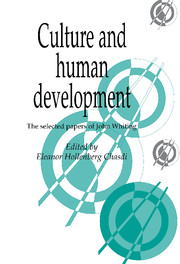Book contents
- Frontmatter
- Contents
- List of figures
- Preface
- Acknowledgments
- Introduction: John Whiting and anthropology
- Fifty years as a behavioral scientist: autobiographical notes
- Part I Theory and methods
- Part II Environment and history
- Part III Moral development
- Part IV Gender development
- Part V Development of social behavior
- Introduction
- 11 Altruistic and egoistic behavior in six cultures
- 12 The duration of maidenhood across cultures
- 13 Social change in adolescent sexual behavior, mate selection, and premarital pregnancy rates in a Kikuyu community
- Bibliography
- Complete bibliography of John W. M. Whiting's work
- Index
12 - The duration of maidenhood across cultures
Published online by Cambridge University Press: 23 December 2009
- Frontmatter
- Contents
- List of figures
- Preface
- Acknowledgments
- Introduction: John Whiting and anthropology
- Fifty years as a behavioral scientist: autobiographical notes
- Part I Theory and methods
- Part II Environment and history
- Part III Moral development
- Part IV Gender development
- Part V Development of social behavior
- Introduction
- 11 Altruistic and egoistic behavior in six cultures
- 12 The duration of maidenhood across cultures
- 13 Social change in adolescent sexual behavior, mate selection, and premarital pregnancy rates in a Kikuyu community
- Bibliography
- Complete bibliography of John W. M. Whiting's work
- Index
Summary
Introduction
Every society has cultural rules and customary strategies whose intent is to ensure reproductive continuity from generation to generation. Viable methods of infant care, child rearing, and mate selection during adolescence are necessary for such continuity. We have chosen to investigate the strategies adopted by various cultures to ensure that a young woman is married at the right time to the right husband. We assume that a limited set of strategies have been devised over the course of social evolution and that their choice is predictable.
Since menarche marks the onset of female fecundity and a wedding legitimates motherhood, the interval between these two events, which we have called maidenhood, will be the focus of this chapter. In the United States, where the median age of menarche is 12.8 years and the median age of marriage is 20.6 years, maidenhood lasts for almost 8 years. In contrast, for most preindustrial societies the period is less than 3 years and in some in which girls marry at or before they first menstruate there is no period of maidenhood at all.
In order to investigate the various strategies regarding maidenhood that have been used over the course of human social evolution two samples will be discussed. The first, shown in table 32 is a set of modern national cultures for which survey data on the age of menarche (Eveleth and Tanner 1976) and on the age of marriage (Dixon 1971) were available for the same time period – 1960–75. The median duration of maidenhood is taken as the difference between these two values.
- Type
- Chapter
- Information
- Culture and Human DevelopmentThe Selected Papers of John Whiting, pp. 282 - 305Publisher: Cambridge University PressPrint publication year: 1993



